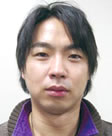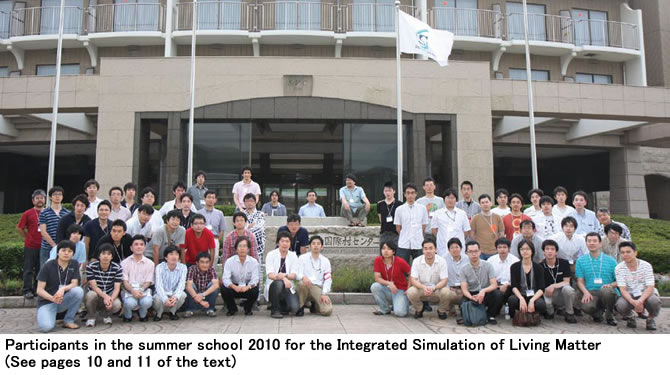
After participation in the summer
school 2010 for the Integrated
Simulation of Living Matter

First year of doctor,s course, The University of Tokyo
Graduate School of Science Ken Saito
I belong to the seminar of Professor Shinya Kuroda of the University of Tokyo, a member of the Brain and Neural System Research and Development team which analyzes intracellular signaling pathways using mathematical models (particularly time-series statistical models). A senior associate in the seminar introduced this summer school to me, and I participated in the summer school because I wanted to meet people in different fields who are related to my research theme, but with whom it is difficult to exchange opinions in my daily research life.
I have been interested in the work of the Data Analysis Fusion Research and Development Team estimating the structure of gene networks using time line data about gene expression, such as SiGN and LiSDAS. Because I have difficulty in appreciating the significance of explanations of signaling pathways using mathematical models, I wanted to hear other opinions about it. When I actually heard the lecture at the summer school, it was impressive that a lot of researchers wanted to apply it in medical practice through modeling. I also heard the story of researchers who have the same directionality as mine, and it was a very valuable experience for me.
Since other lectures handled the theme across various levels from brain and organs to molecules, I was anxious about keeping up with the contents before participation, but actually, the lectures were explained so that the unprofessional people can understand, so I could interestingly hear the lecture of the people far from my specialty to the end. It was particularly good that the presentation topic was explained carefully, especially the motivation for the research and why a supercomputer is required. I had been struggling with the question, “why supercomputers are required for analyzing the functions of organisms,” but now I could sweep away that question.
Particularly, the presentation by the High-performance Computing Team was even more impressive than I had expected. Since the mathematical model that I use now does not require the performance of a computer so much, I was not so interested in the extra speed of parallel computation, but I heard the tuning methodology behind this at the summer school, and this prompted me to have more motivation to study it seriously. In the future, I want to describe thousands of molecular behaviors in cells with one model in an integrated manner, and to utilize the knowledge learned at this summer school.
The matter that I expect from the summer school to be held next year and so on is aggressive participation of students. In all, only 8 students including me participated in this summer school. I think that there is no student who does not know of the “supercomputer project” which came up in conversation at the screening process for government revitalization, but I think that there are few students who really understand what is going on in terms of research themes actually using supercomputers. In order to understand the positioning of scientific research as a national project, I thought it would be very meaningful if more students participate in such an event.
Finally, since not only research, but there were also many recreation events like football and night networking, etc., at this summer school, I think that participants could have a real opportunity to discuss and exchange opinions. I would like express my thanks to the people in the Secretariat of the summer school.

■Program of the summer school 2010
for the Integrated Simulation of Living Matter
“Explanation of purport and keynote lecture”
“Estimation of gene network from gene expression data using a Bayesian networks by nonlinear regression and its parallel algorithm”
“ParaHaplo - Program package to quickly implement analysis related to genome-wide haplotype by parallelization”
“Development of system for estimation of protein-protein interaction network based on steric structure”
“LiSDAS: Life Science Data Assimilation Systems”
“Basis of realistic neural circuit and large-scale computation”
“Simulation of cytoskeleton-dependent change in cell morphology”
“Approach for experimental procedures from an MD”
“Multiple drug discharging transporter AcrB”
“Sampling method applying molecular dynamics – Development of Replica Exchange Interface (REIN) –“
“Hardware and tuning”
“The reason why I hate HPC (High Performance Computing)”
“Intracellular biochemical reaction simulator considering organelles”
“Development of hemostasis and thrombosis simulator connecting cells with an organ model”
“Development of procedures for coupled analysis of fluid structure based on the fixed mesh method”
“Determination of performance for application of next-generation computers”
BioSupercomputing Newsletter Vol.3
- SPECIAL INTERVIEW
- The role of supercomputers is important for integrating various leading-edge research bases for proactive use.
Manager Clinical Development Planning and Management
Mochida Pharmaceutical Co., Ltd. Visiting Professor Tohoku University Kazumi Nishijima - Sonic simulation research in the body which is essential for promotion of ultrasound therapy and development
of therapeutic apparatus
Extraordinary researcher, Department of Mechanical Engineering, School of Engineering, University of Tokyo Akira Sasaki
- Report on Research
- Achievement of a Multiscale Molecule Simulation of QM/MD/CGM(Molecular Scale WG)
Institute for Protein Research, Osaka University
Yasushige Yonezawa / Shusuke Yamanaka / Hiromitsu Shimoyama / Hideki Yamazaki / Haruki Nakamura
RIKEN, Computational Science Research Program Ikuo Fukuda - Towards development and experimental demonstration of liver model based
on large-scale metabolic simulation at individual cellular level (Cell Scale WG)
School of Medicine, Keio University Ayako Yachie-Kinoshita - Exhaustive Protein-Protein Interaction Network Prediction by Using MEGADOCK (Data Analysis Fusion WG)
Graduate School of Information Science and Engineering, Tokyo Institute of Technology
Yutaka Akiyama / Yuri Matsuzaki / Nobuyuki Uchikoga / Masahito Ohue - Whole Brain Simulation of the Insect Olfactory System
Research Center for Advanced Science and Technology, The University of Tokyo Tomoki Kazawa, Stephan Shuichi Haupt
- Report
- The summer school 2010 for the Integrated Simulation of Living Matter was held.
RIKEN, Computational Science Research Program Yasuhiro Ishimine (Organ and Body Scale WG)
The Institute of Medical Science, The University of Tokyo Teppei Shimamura (Data Analysis WG)
RIKEN, Computational Science Research Program Yasuhiro Sunaga (Cell Scale WG)
Kyoto University Graduate School of Informatics Naoki Honda (Brain and Neural WG)
RIKEN, Computational Science Research Program Gen Masumoto (High-Performance Computing Team)
RIKEN, Computational Science Research Program Kosuke Matsunaga (Molecular Scale WG) - After participation in the summer school 2010 for the Integrated Simulation of Living Matter
First year of doctor's course, The University of Tokyo Graduate School of Science Ken Saito
